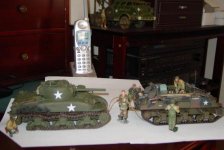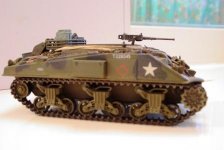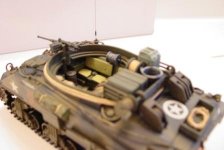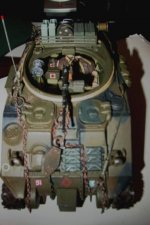jazzeum
Four Star General
- Joined
- Apr 23, 2005
- Messages
- 38,846
I was looking at History of the Second World War, a 96 part weekly magazine that was published back in the 70s.
Anyway, to make a long story short, one of the issues had a photo of a Kangaroo, which, according to the issue, was a Canadian built Ram tank producing by removing the turret. It apparently had many variants. The variant pictured carried ten infantryman.
I did a Forum search and saw that it had been mentioned from time to time so I decided to bring it up again as I think it would make for an excellent release and something a little different.
The following is taken from Wikipedia:
***
In 1944, Harry Crerar's First Canadian Army was concerned by manpower shortages and Lieutenant-General Guy Simonds, commander of the II Canadian Corps, devised Kangaroos as a way of reducing infantry losses.
The first Kangaroos were converted from 102 M7 Priest self-propelled guns of the artillery regiments of the three infantry divisions involved in the initial buttault on 6 June 1944. These were no longer needed, as the artillery regiments were re-equipped with towed 25 pdr guns in late July. At a field workshop (codenamed Kangaroo, hence the name) they were stripped of the artillery equipment and the front aperture welded over, then sent into service carrying twelve troops. They were first used in Operation Totalize south of Caen and subsequently in Canadian attacks on the various Channel ports, operated by the 1st Canadian Armoured Personnel Carrier Squadron.
The Priests were subsequently returned to US custody and other vehicles used. The majority of vehicles converted were Canadian Ram tanks or other Priests (which were sometimes referred to as "unfrocked" or "defrocked" Priests). The name Kangaroo was applied to any similar conversion. In Normandy they were operated by the 1st Canadian Armoured Carrier Regiment (1CACR) and the 49th Armoured Personnel Carrier Regiment under the British 79th Armoured Division (whose specialized vehicles were called "Hobart's Funnies"). Kangaroos were then used throughout the campaign in northwest Europe.
***
Attached are two photos . The second photo is from a Kangaroo at Bovington.
I think this would make an excellent release.
Anyway, to make a long story short, one of the issues had a photo of a Kangaroo, which, according to the issue, was a Canadian built Ram tank producing by removing the turret. It apparently had many variants. The variant pictured carried ten infantryman.
I did a Forum search and saw that it had been mentioned from time to time so I decided to bring it up again as I think it would make for an excellent release and something a little different.
The following is taken from Wikipedia:
***
In 1944, Harry Crerar's First Canadian Army was concerned by manpower shortages and Lieutenant-General Guy Simonds, commander of the II Canadian Corps, devised Kangaroos as a way of reducing infantry losses.
The first Kangaroos were converted from 102 M7 Priest self-propelled guns of the artillery regiments of the three infantry divisions involved in the initial buttault on 6 June 1944. These were no longer needed, as the artillery regiments were re-equipped with towed 25 pdr guns in late July. At a field workshop (codenamed Kangaroo, hence the name) they were stripped of the artillery equipment and the front aperture welded over, then sent into service carrying twelve troops. They were first used in Operation Totalize south of Caen and subsequently in Canadian attacks on the various Channel ports, operated by the 1st Canadian Armoured Personnel Carrier Squadron.
The Priests were subsequently returned to US custody and other vehicles used. The majority of vehicles converted were Canadian Ram tanks or other Priests (which were sometimes referred to as "unfrocked" or "defrocked" Priests). The name Kangaroo was applied to any similar conversion. In Normandy they were operated by the 1st Canadian Armoured Carrier Regiment (1CACR) and the 49th Armoured Personnel Carrier Regiment under the British 79th Armoured Division (whose specialized vehicles were called "Hobart's Funnies"). Kangaroos were then used throughout the campaign in northwest Europe.
***
Attached are two photos . The second photo is from a Kangaroo at Bovington.
I think this would make an excellent release.


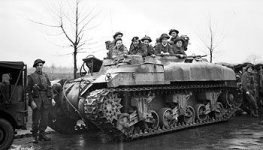
![800px-Ram_Kangaroo_1_Bonvington[1].jpg](/data/attachments/38/38427-70b3d005cdec3072d4fafb63a2d59d95.jpg)
